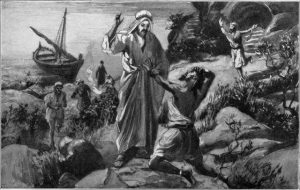
Roger Parvus has posted an intriguing comment about the Gospel of Mark’s narrative of Jesus casting out of the “Legion” of devils (the story where he sends them all into a herd of pigs who then run off a cliff and drown) on Tim Widowfield’s discussion of Wrede’s Messianic Secret. He wonders if the story is in fact a parable or metaphor for Jesus descending to Hell — something we read about cryptically in other parts of the New Testament.
It is a fascinating possibility. Note that the author of Mark’s Gospel claims that Jesus always spoke in a parable of some sort to his disciples (Mark 4:34) and some scholars have even suggested that the entire Gospel narrative itself was written as a “parable” of the Christian’s destiny and way of life — that is, even the acts of Jesus are symbolic. This idea is supported by the clearly symbolic features of a number of the stories, such as Jesus in something of a joint-action healing a woman who had endured a blood-disease for 12 years while raising from a sleep or death a 12-year-old (pubescent) girl. The author also curiously “explains” that the disciples were in shock on seeing Jesus walk on water because they had failed to understand the miracles of the feeding of multitudes with a few loaves and having so many baskets of scraps left over (Mark 6:51-52). There are mysteries in the narratives and sayings in Mark’s Gospel that are lost to us now.
Before I quote here Roger Parvus’s comment, I will quote an extract from another scholar who has broached the same idea that the scene of the exorcism of Legion is a metaphor for Jesus’ despoiling of the demons in Hell:
Eric C. Stewart (Gathered around Jesus: An Alternative Spatial Practice in the Gospel of Mark, pp. 261-2 — a University of Notre Dame thesis) refers to a study that argues Jesus’ voyage to the Gadarenes — where he exorcises the man possessed by Legion — is best read against the Greco-Roman traditions of sailing through the Straits of Gibraltar that were considered the gateways to land of the dead. (I have reformatted the paragraph for easier reading and added hyperlinks to the biblical references.)
Roy Kotansky argues that the story of the Gerasene demoniac is best read against the Greco-Roman traditions of sailing through the Straits of Gibraltar at the edge of the world.837
He first notes that the “other side” in Mark 4:35 has as its antecedent the sea in Mark 3:7.838 This sea is not identified in 3:7 as the Sea of Galilee. Kotansky argues that this sea should be read as the Mediterranean rather than the Sea of Galilee.839 The trip, then, becomes a voyage to the “Other Side,” that is, to the edges of the oikoumene. “Accordingly, all the sea-crossings of both miracle catenae, at least in the mythic imagination, are to be construed as true sea-voyages; their destinations, when recorded, will not tally well with known geographies of the circum-Galilean region.”840 Continue reading “Jesus’ Journey Into Hell and Back — told symbolically in the Gospel of Mark?”
